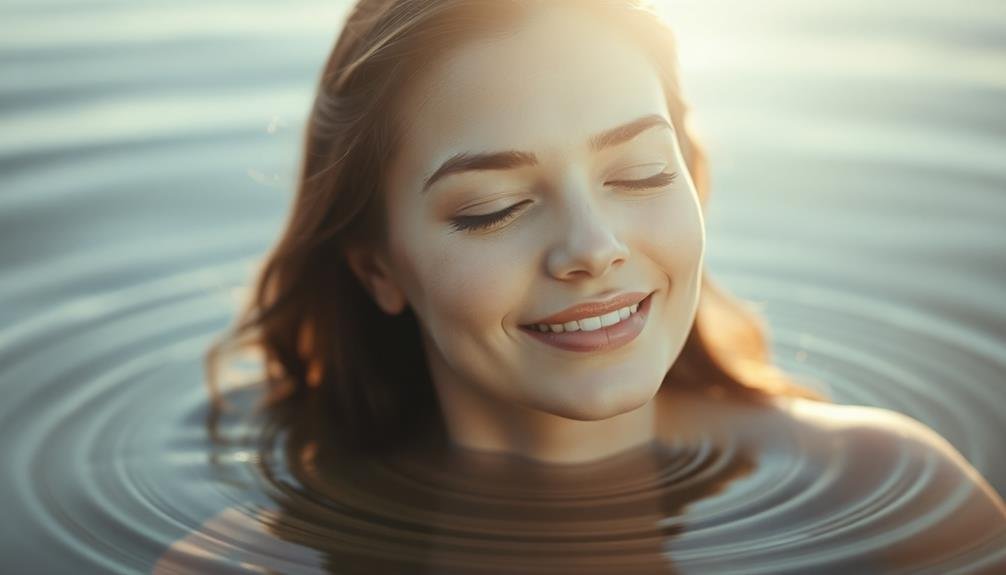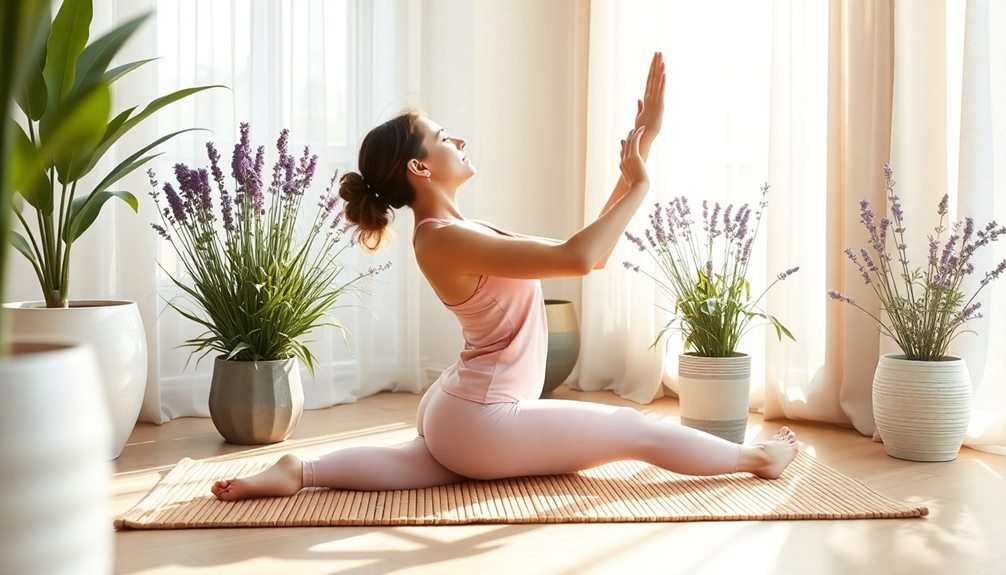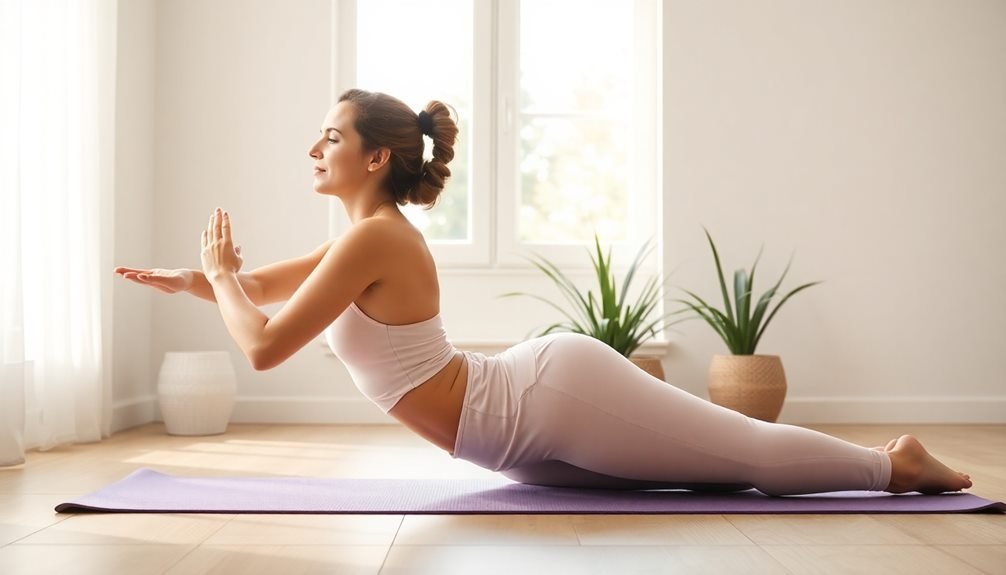Expressive self-portrait photography offers a powerful way to explore and convey your inner peace. You'll need the right equipment, including a camera with manual controls and a sturdy tripod. Set up a quiet, clutter-free space with good lighting to enhance your comfort and creativity. Experiment with poses, expressions, and lighting techniques to authentically represent your state of mind. Use color psychology and props to symbolize your journey. Post-processing can further enhance the mood of your images. By creating a series of self-portraits, you'll gain insights into your path toward inner peace. Dive deeper to reveal the full potential of this transformative art form.
Understanding Inner Peace Through Photography

Delving into self-portrait photography can open up a window to your inner world. As you turn the camera on yourself, you're not just capturing an image; you're exploring your emotions, thoughts, and state of mind. This process can be a powerful tool for understanding and cultivating inner peace.
Start by finding a quiet space where you feel comfortable and relaxed. Set up your camera or smartphone on a tripod or stable surface. Before you begin shooting, take a few deep breaths and center yourself.
As you prepare to take the photo, focus on your feelings of calm and tranquility. You might choose to close your eyes, meditate, or simply sit in stillness.
Experiment with different poses, expressions, and lighting to convey your inner state. Soft, natural light can create a serene atmosphere, while shadows can add depth and introspection. Don't be afraid to try unconventional angles or compositions that reflect your unique perspective on inner peace.
After each session, review your photos and reflect on what they reveal about your inner world. You'll likely discover new insights about yourself and your journey towards peace and self-understanding.
Choosing the Right Camera Equipment
Selecting the right camera equipment for self-portrait photography is essential to achieving your desired results. Start with a camera that offers manual control over settings like aperture, shutter speed, and ISO. DSLRs and mirrorless cameras are excellent choices, but even some high-end smartphones can produce quality self-portraits.
Invest in a sturdy tripod to keep your camera steady and allow for hands-free shooting. A remote shutter release or your camera's self-timer function will help you capture images without touching the camera, reducing shake and allowing you to pose freely.
Lens choice is vital. For full-body shots, opt for a wide-angle lens (24-35mm). For closer portraits, a 50mm or 85mm lens will provide flattering results with minimal distortion. If you're shooting in low light, consider a lens with a wide maximum aperture (f/1.8 or wider) to capture more light and create a pleasing bokeh effect.
Lighting equipment can dramatically improve your self-portraits. A simple reflector can bounce existing light onto your face, while a ring light or softbox can provide even, flattering illumination.
Experiment with different setups to find what works best for your style and the mood you're trying to convey.
Setting Up Your Photoshoot Space

Creating an ideal photoshoot space is vital for successful self-portrait photography. Choose a location that reflects your intended mood and message. If you're shooting indoors, clear the area of clutter and distractions. For outdoor shoots, scout locations in advance to guarantee they're suitable and accessible.
Lighting is essential, so experiment with natural light sources or invest in artificial lighting equipment. Position your camera and any additional gear, like tripods or reflectors, before you begin. Don't forget to set up a comfortable area for reviewing your shots between takes.
To create a space that inspires creativity and self-expression, consider these elements:
- A large mirror to help you visualize poses and facial expressions
- Props that complement your theme or add depth to your composition
- A variety of backdrops or textured surfaces to create different moods
- Comfortable seating or cushions for extended shooting sessions
Remember to prioritize safety, especially if you're using electrical equipment or working with delicate props. Keep your space organized and tidy to minimize distractions and maximize efficiency.
Lighting Techniques for Emotional Expression
Lighting is the secret weapon in your self-portrait arsenal, capable of conveying a wide range of emotions. To capture inner peace, experiment with soft, diffused light. Use a large window or a softbox to create a gentle, ethereal glow that wraps around your face. This technique evokes serenity and tranquility in your images.
For a more introspective mood, try low-key lighting. Position a single light source to one side, creating deep shadows and dramatic contrast. This approach highlights contemplation and self-reflection.
Alternatively, backlighting can produce a dreamy, spiritual effect. Place your light source behind you, creating a halo-like outline that suggests enlightenment or transcendence.
To convey warmth and comfort, opt for warm-toned lighting. Use golden-hour sunlight or adjust your artificial light's color temperature to create a cozy, inviting atmosphere.
For a cooler, more detached feeling, use blue-toned light or shoot during the blue hour after sunset.
Don't forget the power of shadows. Experiment with dappled light through leaves or lace curtains to add texture and depth to your portraits.
Posing for Authentic Self-Representation

When capturing self-portraits, your poses can make or break the authenticity of your images.
Natural, unforced poses will reveal your true self and help viewers connect with your photographs.
Remember that your body language speaks volumes, so consider how your posture, gestures, and facial expressions convey emotions and tell your story.
Natural Poses Reveal Authenticity
Natural poses are the key to authenticity in self-portrait photography. When you aim to capture your true self, avoid stiff or overly staged positions. Instead, focus on movements and postures that feel comfortable and genuine to you. This approach will help viewers connect with the real person behind the lens.
To achieve natural poses, try these techniques:
- Engage in an activity you enjoy, such as reading a book or playing an instrument.
- Capture candid moments by setting up a timer and moving naturally.
- Use props that reflect your personality, like a favorite mug or a cherished heirloom.
- Experiment with different angles and perspectives to find what feels most authentic.
Body Language Speaks Volumes
In self-portrait photography, your body language can convey more than words ever could. The way you position yourself, your facial expressions, and even subtle gestures can reveal your inner state and emotions to viewers. To create authentic self-portraits, focus on relaxed, natural poses that reflect your true self.
Consider the message you want to convey through your body language. Open postures with uncrossed arms and legs suggest confidence and approachability. Closed postures, like crossed arms or hunched shoulders, might indicate vulnerability or defensiveness.
Experiment with different hand positions: hands on hips can show assertiveness, while hands in pockets may appear casual or contemplative.
Your facial expressions are equally important. A genuine smile, with crinkled eyes, can radiate warmth and joy. A thoughtful gaze or furrowed brow might convey introspection or concern.
Don't be afraid to show a range of emotions in your self-portraits.
Capturing Serenity in Natural Settings
Serenity in natural settings offers a perfect backdrop for enchanting self-portraits. When you're aiming to capture inner peace through your lens, nature provides an unparalleled canvas.
You'll find that the tranquility of the outdoors can beautifully reflect your inner state, creating powerful and evocative images.
To make the most of natural settings, consider these elements:
- Golden hour lighting: Utilize the soft, warm glow of sunrise or sunset to create a dreamy atmosphere.
- Water reflections: Incorporate still lakes or gentle streams to add depth and symmetry to your compositions.
- Lush greenery: Surround yourself with verdant foliage to evoke a sense of growth and renewal.
- Open spaces: Use expansive fields or beaches to convey a feeling of freedom and possibility.
As you compose your shot, focus on your connection with the environment. Let your body language and facial expressions reflect the serenity of your surroundings.
Experiment with different poses and perspectives, such as sitting peacefully by a tree or gazing out over a scenic vista.
Incorporating Symbolic Objects and Props

Symbolic objects and props can elevate your self-portraits, adding layers of meaning and personal significance to your images. To incorporate these elements effectively, start by selecting items that resonate with your inner journey or represent aspects of your personality. Choose objects that tell a story or evoke specific emotions, such as a cherished book, a family heirloom, or a natural element like a flower or seashell.
When composing your shot, consider how the prop interacts with your body and the surrounding environment. You can hold the object, place it in the foreground, or position it strategically within the frame. Experiment with different angles and lighting to highlight the symbolism of the prop.
Don't be afraid to use unconventional items that may seem out of place at first glance – these can create intriguing contrasts and spark curiosity in viewers.
Remember that less is often more when it comes to props. A single, well-chosen object can be more powerful than multiple items competing for attention. As you practice, you'll develop a keen eye for selecting and incorporating symbolic elements that enhance your self-portraits and deepen their emotional impact.
Exploring Color Psychology in Portraits
Color wields immense power in self-portrait photography, shaping the mood and message of your images. By understanding color psychology, you'll be able to create more impactful and emotionally resonant self-portraits.
Consider the emotions and associations different colors evoke. Warm tones like red, orange, and yellow can convey energy, passion, and warmth, while cool tones like blue and green often suggest calmness and serenity.
When exploring color in your self-portraits, try these techniques:
- Use monochromatic color schemes to create a cohesive, focused mood
- Experiment with complementary colors for striking contrasts and visual interest
- Incorporate color gels or filters to alter the overall tone of your image
- Play with color blocking in your composition to draw attention to specific elements
Don't be afraid to break traditional color rules to express your unique vision. You can use unexpected color combinations to challenge viewers' perceptions or create a surreal atmosphere.
Post-Processing for Enhanced Mood

While capturing the perfect self-portrait is essential, post-processing plays a significant role in enhancing the mood and atmosphere of your image. You'll want to focus on adjustments that amplify the emotional impact of your self-portrait.
Start by fine-tuning the overall exposure, ensuring highlights and shadows are balanced to create depth and dimension.
Experiment with color grading to evoke specific emotions. Warm tones can convey comfort and happiness, while cool tones might suggest calmness or melancholy. Adjust the saturation and vibrancy to either intensify or mute colors, depending on your desired mood.
Don't underestimate the power of contrast. Increase it for a bold, dramatic look, or decrease it for a softer, dreamier feel. Apply selective adjustments to draw attention to key areas of your portrait, such as your eyes or facial expression.
Consider using vignettes or subtle blur effects to direct focus and create a sense of intimacy.
Creating a Series of Self-Portraits
Creating a series of self-portraits can take your photography to the next level. It allows you to explore different facets of your personality and artistic vision over time. When planning your series, choose a unifying theme or concept that resonates with you. This could be an emotion, a personal journey, or a visual style you'd like to explore.
Consider these elements to create a cohesive series:
- Consistent lighting: Use similar lighting setups across your images to maintain a unified look.
- Color palette: Stick to a specific color scheme that complements your theme.
- Props and wardrobe: Select items that reinforce your concept and create visual continuity.
- Locations: Choose settings that enhance your narrative and mood.
As you progress through your series, don't be afraid to experiment and evolve your ideas. Each image should build upon the previous one, creating a narrative arc that engages viewers.
Remember to leave room for spontaneity and unexpected discoveries along the way. By committing to a series, you'll develop a deeper understanding of your artistic voice and create a body of work that showcases your growth as a photographer.
Sharing Your Journey Through Images

Once you've created a compelling series of self-portraits, it's time to share your journey with the world. Choose platforms that align with your goals and audience. Instagram and Flickr are popular for photographers, while personal websites offer more control over presentation.
Consider creating a cohesive narrative by arranging your images chronologically or thematically. When sharing, provide context through captions or accompanying text. Explain your inspiration, techniques used, and personal growth throughout the series.
Be vulnerable and honest about your experiences, as this authenticity will resonate with viewers. Engage with your audience by responding to comments and encouraging discussions about self-reflection and personal growth.
Don't limit yourself to online sharing. Explore local galleries, coffee shops, or community centers for exhibition opportunities. Organize a small exhibition or collaborate with other artists for a group show.
Print your best images and create a physical portfolio or photo book to showcase your work in person.
Frequently Asked Questions
How Can I Overcome Self-Consciousness When Taking Self-Portraits?
You can overcome self-consciousness by practicing self-acceptance, focusing on your unique qualities, and experimenting with different poses. Start small, use a timer, and remind yourself that it's about self-expression, not perfection. Embrace your authenticity and have fun!
What Are Some Unique Locations for Expressive Self-Portrait Photography?
You'll find unique locations for self-portraits in abandoned buildings, reflective surfaces, or nature's hidden gems. Try rooftops, subway stations, or underwater scenes. Don't forget unconventional spots like inside a fridge or behind sheer curtains.
How Often Should I Create Self-Portraits to Document Personal Growth?
You'll benefit from creating self-portraits monthly or quarterly to track personal growth. However, don't force it; let inspiration guide you. Be consistent but flexible, allowing your journey to unfold naturally through your lens.
Can I Use Smartphone Apps to Achieve Professional-Looking Self-Portraits?
Yes, you can use smartphone apps for professional-looking self-portraits. They offer filters, editing tools, and AI enhancements. However, don't rely solely on apps. Focus on lighting, composition, and authenticity to truly capture your essence.
How Do I Handle Negative Reactions to My Self-Portrait Work Online?
You should focus on constructive feedback and ignore trolls. Don't take negative comments personally. Remember, art is subjective. Engage with supportive communities, and use criticism to improve your work. Stay true to your creative vision.
In Summary
You've commenced on a powerful journey of self-discovery through the lens. By mastering the technical aspects and delving into the emotional core of your self-portraits, you've created a visual narrative of inner peace. Remember, this is an ongoing process. Keep experimenting, stay authentic, and don't be afraid to share your evolving story. Your images will inspire others and serve as a personal reminder of your growth and serenity.





Leave a Reply